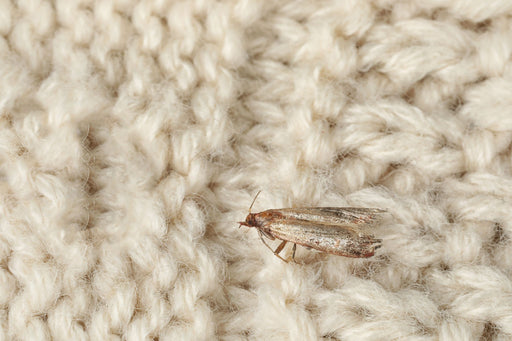How to Fight a Moth Infestation Fast

Moths aren’t dangerous to humans or pets, but that doesn’t mean you want them squatting in the darkest spaces of your home and chewing on your clothing or food. When moths are in your home, you’re going to find that your cosiest cashmere and wool clothing has dozens of holes; the cereals and oats in the pantry are home to wriggling larvae; and there is webbing, excrement, and cocoon casings everywhere. Sounds horrible, right?
Discovering the signs of a moth infestation can be unsettling, but knowing whether you have an infestation and what type of infestation you have will help you take swift and effective action. You need to enact a multi-step strategy for dealing with moths that is more than just tossing a few moth balls into a room and hoping for the best.
We’ve got the answers on how to fight a moth infestation fast.
What Attracts Moths?
One of the best ways to prevent a moth infestation is to be proactive and eliminate the things they like. Moth infestations occur when the temperatures are warm and the humidity high. During these periods, adult moths seek out places to mate and lay eggs any place that is suitable to their larvae. Depending on the type of moth, that could be among the dried grains or pet kibble in the kitchen, among the upholstery or carpets in the spare room, or even in the folds of your favourite wool socks and pullovers.
What do all those locations have in common? Food. Moths, regardless of their type, are all searching for the food their larvae need to survive. For clothes moths and carpet moths, the main source of food is called keratin, which is a protein found in human hair, wool, cashmere, and similar natural fibres. For pantry moths, such as the Indian Meal Moth or the Mediterranean Food Moth, grains and dried foodstuffs are what they want.

Signs of Moth Infestation
Although different species of moths look and act different, there are some overarching signs that you have a problem. Look out for the following:
- Irregular holes in your clothing
- Fur garments and accessories that shed excessively
- Moths flying around or crawling on items in your home
- Silky tunnels or furrows found near or in wool fabric and clothing; also sometimes seen in grains and other dried foods
- Crust-like spots on rugs, draperies, and clothing
- Tiny, sticky tubes (larva casings) on fabric and rugs or in the corners of a room/closet
But how do you tell if it’s a clothes moth, carpet moth, or pantry moth infestation? Take a look below.
Signs of a Clothes Moth Infestation
Most people first notice that they have a clothes moth problem when they find holes in their clothing that weren't there before. Or you might notice the larvae or case trails in the drawer or adult moths flitting about.

As mentioned earlier, clothing made from natural fibres and materials, such as silk, leather, wool, angora, alpaca, and cashmere, are the primary targets. You might find that a cotton shirt here and there has been eaten, but that is normally caused by stains from food and perspiration. Even damp clothing will attract moths, no matter the material.
To understand the best approach to controlling clothes moth damage, you need to read our article on How to Get Rid of Clothes Moths and Their Larvae.
Not all moths in your house are clothes moths. When it comes to clothes moth identification, webbing clothes moths and casemaking moths are those responsible for holes in your clothing.
MothPrevention.com offers you the Proven Range for Clothes Moth Control including Clothes Moth Traps for adult moths and Clothes Moth Killer Kits to eliminate clothes moth larvae. We've worked closely with our suppliers to bring you a focused range of products that are backed by our 100% Satisfaction Guarantee.
Signs of Carpet Moth Problems
Carpet moths are often adept at hiding, much like clothes and pantry moths. The problem is that you won’t notice the infestation until most of the moths have hit the larval stage. The carpet will suddenly look threadbare, since the larvae are chewing through the fibres. You might also spot tubular case trails.
If you suspect that you have a carpet moth infestation, look around the darker sections of the carpet or room, such as the baseboards or under furniture that is pushed up against a wall.
Need help figuring out what kind of cloth-eating moth your home is infested with? Check out our tips for identifying clothes and carpet moths.
The carpet moths themselves have similar moth life cycles to clothes moths – see our Carpet Moth Identification Guide for more details. The larvae may be difficult to spot in coloured carpet pile because they can take on the colour of the fibres that they have eaten.
Signs of a Pantry Moth Problem
You know those old cartoons where someone goes to a bare cupboard and a little moth flies out? A pantry moth infestation is a little like that—you often find an adult moth flitting around when you go to grab a midnight cereal snack. But you might not think anything of a moth in the kitchen until you find that very box of cereal is home to hundreds of wriggling white or pink larvae. You might also find clusters of eggs or larvae in the shadowy corners of the cupboard or pantry.
There are three kinds of pantry moths—Indian Meal Moth, Mediterranean Flour Moth, and Brown House Moth—but they generally display the same behaviours. No matter which kind is in your home, you can use the same prevention and removal methods for each species.
Pantry moths aren't attracted to the same pheromones as clothes moths, so the traps for them are completely different products. This is a common misunderstanding with many people facing their first moth infestation. The great news is Moth Prevention Pantry Moth Traps catch all species of pantry moth!
How to Remove Moths from Your Home

Treating a moth infestation can be a long road, especially if you aren’t thorough. Moths might not be as indestructible as other insects, but they are persistent, and they’ll hide their eggs where you wouldn’t think to look. Be sure to first identify the type of moth you have in your home then decide how to proceed. Also, if you use the tips below proactively, you can prevent a moth infestation from ever occurring!
So take notes if you have to, because you’ll want to start doing these things right away:
- Identify the type of moth in your home - different treatments are necessary for different moth types
- Prevent further moth breeding - hang moth traps and intercept the male flying house moths
- Scrub areas you suspect to be infested - using an effective moth killer spray, scrub and clean including crevices and corners
- Remove infested items - Items that can't be cleaned should be discarded
- Dust and vacuum - floors, crevices and anywhere you've used moth killer spray
- Wash clothing, carpets or containers thoroughly - don't place anything back into position without a clean to prevent risk of re-infestation
- Monitor and be vigilant - use moth traps to defend against infestation
Now let’s look at the ways to fight a moth infestation in closer detail.
Step 1. Identify which type of moth you have in your home
Identifying which type of moth you have in your home is critical to using the correct treatment. Pheromone moth traps use an attractant that's designed to attract specific species of moth. If you mis-identify your moth species, you could find your treatment ineffective.
See our clothes & carpet moth identification guide here and pantry moth identification guide here
Step 2. Prevent further moth breeding with pheromone moth traps
Hang pheromone moth traps designed to attract and trap the male adult (flying moths) preventing them from fertilizing the female's eggs. This will also allow you to gauge the intensity of the infestation by counting the number of moths trapped per day and week.
Step 3. Scrub down infested areas with moth killer spray
Have you found signs of moth eggs and larvae and cocoons in your house? You may want to vacuum affected areas to begin, but using a powerful but natural moth killer spray to scrub the affected areas is a must - as soon as you can. Other guidance may suggest you mix together a water and vinegar solution - this can work, but a specially formulated moth killer spray will be many times more effective. Spray the, moth killer spray or solution wherever you found the eggs - carpets, shelves, cupboards, drawers, baseboards…all of it - and then scrub it all down with a sponge.
Be sure to use an appropriate moth killer spray for the location you're cleaning. If dealing with a pantry moth infestation in your kitchen, be sure to use a natural specially formulated moth killer spray. At MothPrevention we've developed a kitchen safe pantry moth killer spray that's safe to use on food preparation surfaces.
If it's a carpet moth infestation, check out our carpet moth killer sprays.
On the other hand, if you're dealing with a clothes moth infestation, you should take a look at our clothes moth killer sprays.
Step 4. Remove infested items that can't be cleaned or are beyond cleaning
In cases where food is involved, it can often be best to simply throw out the infested packets and containers of food - and thoroughly clean any reusable containers.
Other instances where clothes or carpets have sustained so much damage from moth larvae munching away at them, it may be worth just letting them go and parting ways with them. Please don't donate them! Simply throw them away.
Step 5. Dust and vacuum your floors, carpets, and moldings
Cleaning your home is one of the best things you can do to quell a moth infestation, because you are actively sweeping up the things moths feed on, as well as the eggs and larvae.
Always empty the dust and dirt from your vacuum cleaner outside as soon as you can. Any swept up eggs or larvae could hatch and multiply in the vacuum cleaner (and there’s plenty of stuff for them to eat in there).
Step 6. Wash clothing, containers or anything else that may contain eggs and larvae
If you haven't cleaned it already, now's time to clean everything else! If it's a clothes moth infestation, it's time to wash the contents of your wardrobe. If it's a pantry moth infestation, it's time to clean food containers. If it's a carpet moth infestation, it may be time to clean surrounding furnishings.
If you have a trusted dry cleaner, now is the time to bring your silks, wool, cashmere, and alpaca garments to them. Dry cleaning can kill moth eggs, and some dry cleaners will even repair holes made by moths.
Step 7. Monitor and be vigilant, using moth traps to defend against infestation
Once you've completed the hard work of eliminating your moth infestation, the last thing you want to be doing is repeating step 1-6 again! So to keep your house clear of moth infestations, hang pheromone moth traps and keep them fresh, potent and powerful in the defense against house moths.
How to Prevent Moths in Your Home
If you use the tips below proactively, you can prevent a moth infestation from ever occurring!
- Use Sticky Pheromone Moth Traps To Monitor Moth Activity
- Brush clothing made from wool or fur after wearing
- Store clothing and accessories in protective bags or bins
- Store foodstuffs in airtight containers
Alternative methods (Repelling methods):
- Use herbs, spices, and essential oils to repel moths
- Use cedar in your closets and around the house
1. Use sticky pheromone moth traps
There are numerous moth traps out there. Some are plain sticky traps that work like fly paper. Others have moth pheromones that attract the sexually adult males to the trap, so that eggs can’t get fertilized or laid. Once the moths are stuck, they’ll die in due time.
Keep in mind that the pheromones that attract pantry moths do not always work on carpet and clothes moths and vice versa. Make sure you are purchasing the correct pheromone trap, whether a clothes or carpet moth trap or a pantry moth trap, for the occasion.
2. Brush clothing made from wool or fur after wearing the articles outside.
Believe it or not, moths can be little ninjas that infiltrate the fibres of your wool sweater or jacket, so you carry them into your home, none the wiser. One way to prevent this from happening is to routinely brush clothing made of animal-based fibres, effectively scraping off the eggs.
3. Store your seasonal clothing, belongings.
When you’re not wearing your cashmere pullovers and wool socks, store your cashmere and wool in plastic containers, fabric garment bags, and cedar chests to keep moths at bay. If the containers are airtight, moths can’t get inside to lay their eggs.
4. Store foodstuffs in airtight containers
The same is true for your foodstuffs. Never leave dried grains, rice, pasta, pet food, dried fruits, or anything similar out in the open. Always store them in something secure.
Alternative methods:
Use herbs, spices, and essential oils around the house.
If you have a spice rack, you already have the moth-fighting essentials! Combine lavender, cloves, rosemary, thyme, and bay leaves into a little cloth sachet that you can hang in your closet or place in your room. Moths dislike the odours of these herbs and spices.
Another option is getting essential oils—lavender, peppermint, rosemary, eucalyptus—and dilute them with water. Spray the solution around your house or add to a diffuser for a longer lasting (and lovely scented) moth repellent.

These herbal methods don't have great potency or longevity - therefore we highly recommend using moth traps that attract the male moths (not repelling them) and then traps them - removing them from the breeding cycle - preventing the female moths from having their eggs fertilized.
Grab some cedar hangers, blocks, and shavings
One of the most commonly known materials is cedar, which has the power to repel moths - take a look at our article discussing using cedar as a moth repellent. One the reasons why cedar hangers, blocks and balls exist is because of their moth repelling power. You can put the blocks, balls, and shavings in your wardrobe and bureau drawers, and the scent keeps moths from feasting on your clothing.
Now, a quick note. Cedar is often thought of as the be-all-end-all in the war against moth infestation, but it does have a limited lifespan.
Fortunately, you can always refresh and replace any cedar products in your home. You can purchase cedarwood oil to rejuvenate your cedar products, use cedar oil in a diffuser, or mix some cedar chips into a bowl of seasonal potpourri (remember: herbs and spices work for a short period of time, repelling certain bugs).
Restoring the repelling power of your cedar blocks and hangers may well be a lot more effort than replacing a stick strip in a pheromone moth trap - and would need to take place at a similar interval.

Detecting Moth Problems
Moth pheromone traps – provide a way of detecting signs of adult moth activity in your home:
Clothes Moth Traps – where the sticky clothes moth pheromone trap strips can be replaced to extend the life of the moth traps
Pantry Moth Traps – special pheromone moth traps that are safe to use in the kitchen
Carpet Moth Traps – use where you have seen sightings of moths and/or larvae to capture the male moths and break the breeding cycle
Moth traps – also act to break the breeding cycle by attracting and trapping the male adult moth so they offer more than just monitoring.
You're not alone in the battle to fight a moth infestation in your home!
Do all these things before, during, and after a moth invasion, and you should have things under control faster than you thought possible. Even if it doesn’t seem like your moth problem has gotten out of hand, make sure you are vacuuming and cleaning regularly. Seal up your knitwear when they’re not in use, and utilise cedar, herbs and spices, and also sticky moth traps or pheromone traps such as our clothes moth pheromone traps.
FAQs on How to Fight a Moth Infestation Fast
Now that you've got a better understanding of how to remove moths from your home quickly and efficiently, let's go over some frequently asked questions on finding, fighting, and preventing moths.
How to find a moth infestation in your home?
There are many telltale signs of a moth infestation. To find the most infested areas in your home, look for larval casings and dead moths nearby. If you notice these signs and have determined that you likely have a moth infestation in your home, uncovering its source is the first thing to do. Only after you find the primary source of an infestation can you begin thoroughly eliminating the moths.
Clothes Moths prefer to inhabit areas near food sources containing animal based fibres. These moths enjoy dark, quiet, rarely visited areas where they can lay eggs. In time, these eggs hatch into ravenous moth larvae and eat their way through cashmere, silk, leather, wool, and even garments that are soiled or blood stained.
So, if you have noticed signs of Clothes Moths in your home, search your drawers, wardrobe, or any storage bins where these materials may be stored. Don't forget to look up high on shelves where you are storing clothes and down low near baseboards or behind furniture.
If you suspect an invasion of Pantry Moths, look for infested dry good food items. Oftentimes, Pantry Moth Larvae can be found in cardboard boxes and paper bags where food sources are easy to access by chewing holes through the packaging. Boxes or bags of rice, dog food, bird seed, flour, cake mixes, and other shelf-stable items can be a hotbed for Pantry Moth Larvae.
Also, check in any plastic bags, bins, or even spice drawers where dry goods are exposed to the open air. Even a small crack or opening could be enough for Pantry Moth Larvae to get in. Be sure to thoroughly check cracks and crevices for hidden moth eggs and crawling larvae as you clean.
What are some ways to tell if I have a house moth infestation?
The two main kinds of pestilent house moths are Clothes Moths and Pantry Moths. Both of these moth species can be very destructive. The adult moths themselves are not necessarily the problem. Instead, their larvae can wreak havoc on clothing made from animal based fibres and dry goods in your pantry or kitchen.
Signs of Clothes Moths include moths flying around, holes in clothing, larval casings, sticky eggs that resemble spider webs, dead larvae, and dead adult moths. Pantry Moth infestation signs are similar. Signs of a Pantry Moth infestation include holes chewed in the edges of boxes or bags, dead Pantry Moth Larvae, dead adult moths, larval casings, fragments of moths or their casings in flour, sugar, or other dry food goods, and sticky webbing in cracks, drawers, cupboards, or crevices.
Do I have to call exterminators for a moth infestation in my house?
Although moth infestations can be frustrating, they do not necessarily require a call to the exterminator. In fact, pest control companies are rarely necessary for run-of-the-mill moth infestations. In most cases, you can eliminate moths from the home using natural methods and thorough cleaning techniques.
For example, freezing infested items for 72 hours is a great way to kill moths, eggs, and larvae. You can also use a moth-killing spray which is included in our MothPrevention Killer Kit to eliminate a Clothes Moth infestation in your home. After you have removed moths from your house, natural moth-repellent sachets can be used to deter them from returning and Moth Traps can be positioned to help break the breeding cycle and monitor for any further moth presence.
What causes a moth infestation?
Moth infestations can be caused by many factors. Although moths often infest areas that are rarely visited or uninhabited, sometimes, they will happily take over spaces that you regularly use. If you notice an infestation in its early stages, it will be more manageable.
Keep in mind that just because you are dealing with a moth infestation does not mean that you have a dirty home. Moths are attracted to food sources for their larvae to consume. For instance, Pantry Moth Larvae love dry stored food goods such as flour, cereal, rice, grain, and even dog food. Clothes Moth Larvae will eat animal based fibres such as cashmere, wool, silk, and leather. Just having these materials in your home may be enough to attract moths.
Open windows, cracks in the siding of your house, or chimneys are all avenues that moths may use to get inside your house. You may also accidentally bring moth eggs into your home by buying used items like rugs or couches. Pantry Moths can get into your home if their eggs are already inside the goods that you buy at the grocery store. In many cases, Pantry Moths lay eggs in food goods before they are even packaged!
Instead of focusing on what attracts moths, direct your attention toward what can repel them or nip them in the bud. Moth-repellent sachets, for instance, can help to keep moths out of your clothes. These sachets can be hung in a closet or placed in plastic storage totes where you are storing clothing made of materials such as cashmere, wool, and silk.
To keep Pantry Moths out of your home, inspect your drygoods regularly for signs of larvae. Placing Pantry Moth Traps can also be very effective at keeping these pests out of your house.
How to get rid of a moth infestation quickly?
Not all moth infestations can be treated easily. However, with some diligence, you can get these pests out of your house. To quickly and effectively treat a moth infestation, first, locate its main source. Usually, moths will be heavily infesting one area, food item, or clothing drawer. Next, identify the type of moth in your home and take steps to prevent an infestation from spreading.
Scrub all infested areas using an effective moth-killer spray which is included in our MothPrevention Clothes Moth Killer Kit. Remove any infested items during this process. Either throw infested food/clothing away or freeze things for at least 72 hours to kill moth larvae and eggs.
Dust and vacuum thoroughly and then wash all clothing, carpets, or containers near the infestation site. Position Moth Traps in order to monitor for any further moth presence and help break the breeding cycle.
About MothPrevention
MothPrevention® speak to customers every day about their clothes moth issues - clothes moths are a species that are ever increasing and that can cause significant damage to clothes, carpets and other home textiles.
To date, we’ve helped over 250,000 customers deal with their moth problems. We have developed professional grade solutions including proprietary pheromones and trap design engineered to the highest production standards.





